First aid provides immediate care for injuries or illnesses, preserving life and reducing harm. The DRSABCD approach guides action, emphasizing Step 3 as a critical moment to call for emergency assistance.
What is First Aid?
First aid is the immediate care given to someone injured or suddenly ill to preserve life, prevent worsening, and promote recovery. It involves simple, non-invasive procedures that can be performed with minimal equipment. The DRSABCD approach (Danger, Response, Send for help, Airway, Breathing, CPR, Defibrillation) provides a structured framework for first aiders; Step 3, “Send for help,” is critical, as it ensures professional medical assistance is summoned promptly. First aid does not replace professional medical care but serves as a vital initial response. Proper training is essential to apply these steps effectively, especially in life-threatening situations. Resources like printable guides, online courses, and flashcards can help individuals master these techniques; Understanding the principles of first aid empowers individuals to act confidently in emergencies, potentially saving lives and reducing long-term harm.
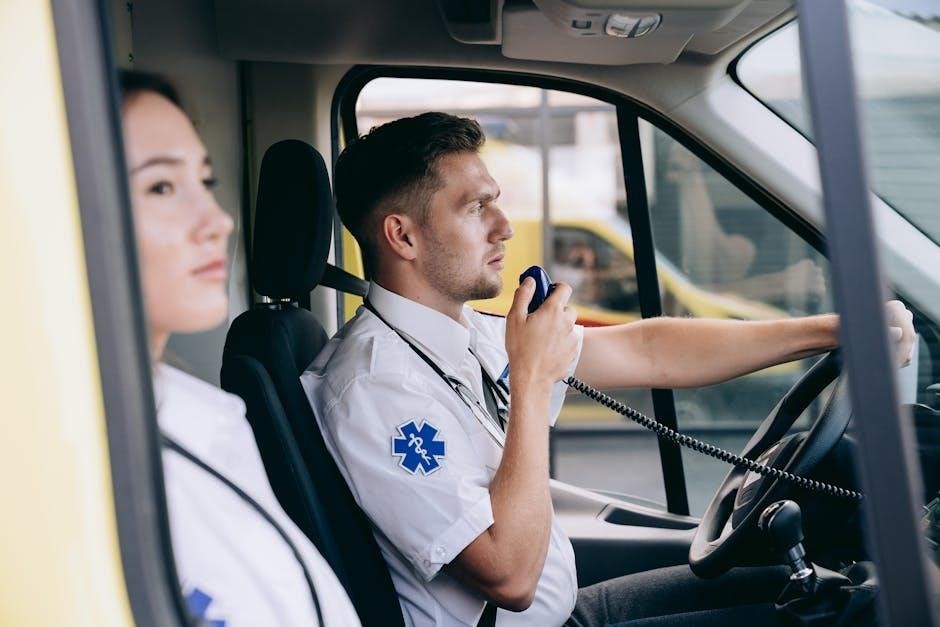
The 3 Cs of First Aid: Check, Call, Care
The 3 Cs of First Aid—Check, Call, and Care—provide a straightforward framework for responding to emergencies. Check involves assessing the scene and casualty to ensure safety and identify the nature of the injury or illness. Call requires summoning professional help by contacting emergency services, a critical step emphasized in Step 3 of the first aid process. Care entails providing immediate, appropriate assistance based on the situation, such as administering CPR or applying bandages. These steps ensure a logical flow of actions, prioritizing safety and effectiveness. Proper training enhances the ability to execute these steps confidently. Resources like printable first aid guides and online courses can help individuals master the 3 Cs, enabling them to act decisively in emergencies. By following this approach, first aiders can make a significant difference in preserving life and reducing harm until professional help arrives.
The DRSABCD Approach
The DRSABCD approach is a structured method for providing first aid, emphasizing a logical sequence of actions. Danger: Ensure the scene is safe for both the first aider and the casualty. Response: Check if the person is conscious and able to respond. Send for help: Summon emergency services, a critical step highlighted in Step 3. Airway: Clear the person’s airway to ensure breathing is possible. Breathing: Check for normal breathing patterns and provide assistance if needed. CPR: Perform cardiopulmonary resuscitation if the person is unresponsive and not breathing. Defibrillation: Use an automated external defibrillator (AED) if available and trained to do so. This systematic approach ensures that first aid is delivered effectively, addressing life-threatening conditions promptly. Proper training in the DRSABCD method is essential for anyone aiming to provide confident and competent care in emergencies, aligning with resources like printable first aid guides and online courses.
Importance of Step 3 in First Aid
Step 3, Send for Help, is a critical component of the first aid process, ensuring professional medical assistance is summoned promptly. Delaying this step can lead to worsening of the casualty’s condition, especially in life-threatening situations. Timely intervention by trained professionals significantly improves outcomes, making this step vital for effective care. Proper training emphasizes the importance of Step 3, as it bridges the gap between initial assessment and advanced medical support. Without this step, even the best first aid efforts may fall short in preventing further harm or saving a life.
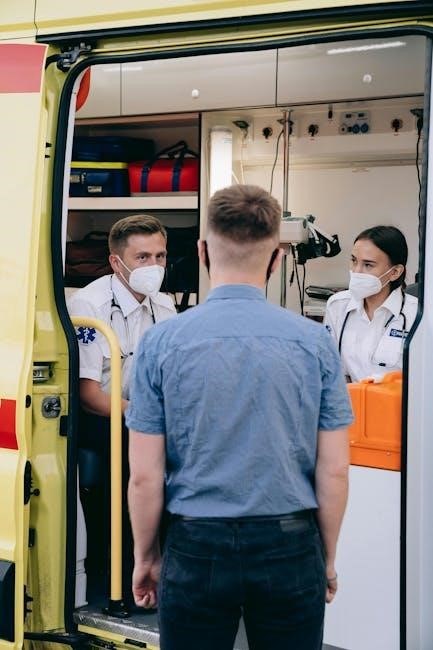
Steps Before Step 3
Before proceeding to Step 3, ensure the scene is safe and assess the casualty’s response. These initial actions are crucial for both the rescuer’s safety and the victim’s proper care.
Step 1: Ensure Scene Safety
Ensuring scene safety is the first and most critical step in providing effective first aid. Before approaching the casualty, assess the environment for potential hazards such as falling objects, slippery surfaces, or exposed wires. Your safety is paramount, as you cannot help others if you become injured. If the scene is unsafe, do not risk your life—instead, call for professional help immediately. Once the area is deemed safe, you can proceed to check the casualty’s condition. This initial assessment ensures that both you and the victim are protected from further harm. Remember, a safe environment allows for focused and effective care. Always prioritize caution to avoid exacerbating the situation. By securing the scene first, you create a stable foundation for the subsequent steps in the first aid process.
Step 2: Check for Response
After ensuring the scene is safe, the next step is to check the casualty’s responsiveness. Gently shake the person’s shoulder or tap their chest to gauge their reaction. Ask clear, loud questions like, “Are you okay?” or “Can you hear me?” to assess their level of consciousness. If the person responds, they are conscious, and you can proceed to evaluate their condition further. If there is no response, it indicates the casualty is unresponsive, and immediate action is required. Checking for responsiveness helps determine the severity of the situation and guides the next steps in providing care. This step is crucial for identifying if the casualty needs urgent medical attention or if they can remain in your care until professional help arrives. Always remember to stay calm and methodical during this process to ensure accurate assessment.
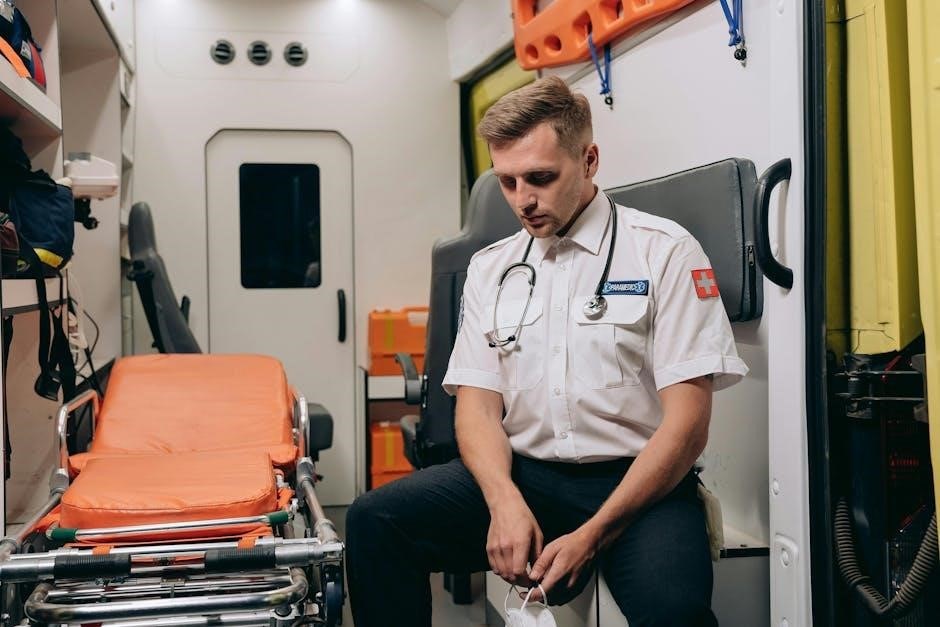
Step 3: Send for Help

In the DRSABCD approach, Step 3 involves sending for help immediately after checking for response. Call emergency services, provide clear information, and use technology like emergency apps if available to expedite assistance.
How to Send for Help
When sending for help in a first aid situation, it is crucial to act quickly and calmly. The first step is to call the local emergency number, such as 911 or 999, and provide clear, concise information about the situation. Include details like the location, the number of casualties, and the nature of the injury or illness. If possible, use a phone app or device that can share your location automatically. In remote areas, ensure someone reliable can convey the message to authorities. Additionally, use any available technology, such as emergency response apps, to alert others or summon assistance. If you are in a group, assign one person to call for help while others provide care. Remember, the goal is to minimize delays and ensure professional medical aid arrives as soon as possible. Prompt action can significantly impact the outcome for the casualty.
Information to Provide When Calling Emergency Services
When contacting emergency services during a first aid situation, it is essential to provide accurate and detailed information to ensure a swift and effective response. Start by stating your location clearly, including the address or nearest landmarks if possible. Next, explain the nature of the emergency, such as whether it involves an injury, illness, or accident. Specify the number of casualties and their conditions, noting if anyone is unconscious, breathing difficulties, or experiencing severe injuries like bleeding or burns. Also, mention any immediate risks or hazards at the scene, such as fire or falling debris. Be prepared to follow any instructions given by the operator and stay on the line until help arrives. Clear communication ensures emergency responders are well-informed and can prioritize resources effectively. This step is critical in the DRSABCD approach, as timely professional assistance can significantly improve outcomes for the casualty.
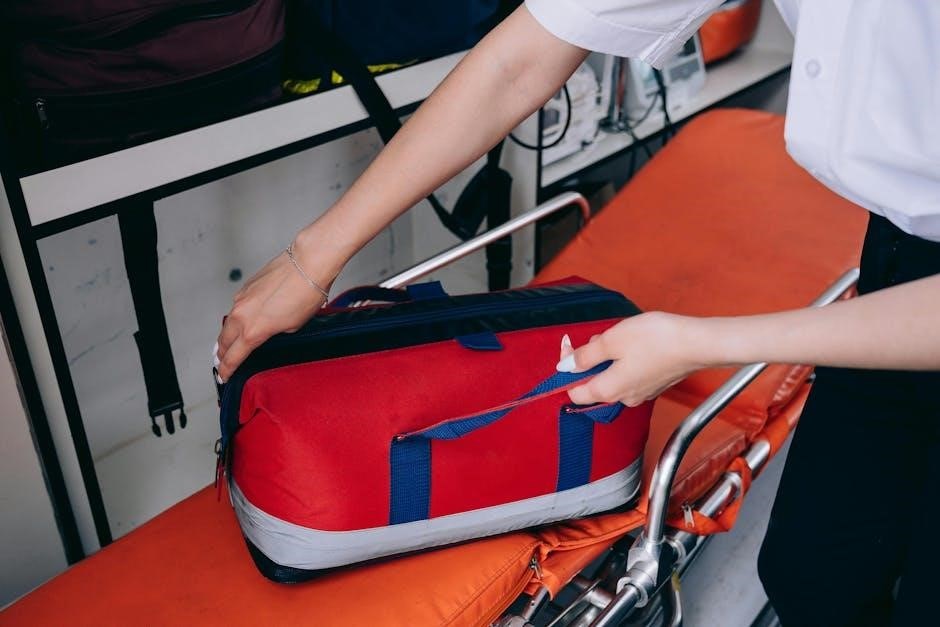
Why Sending for Help is Crucial
Sending for help is a critical step in first aid, as it ensures professional medical assistance is summoned promptly. Without this step, even the best first aid efforts may fail to prevent deterioration or save a life. Emergency services are equipped with advanced tools and trained personnel to handle severe injuries or illnesses. Delaying this step can lead to worsening conditions, such as uncontrolled bleeding or cardiac arrest, which require immediate intervention. Additionally, alerting emergency services allows them to prepare appropriate resources, like ambulances or fire trucks, based on the situation. A first aider can only do so much, and professional help is often necessary to stabilize and transport the casualty. Timely help can mean the difference between recovery and long-term harm or even death. Thus, sending for help is not just a step—it’s a lifeline that connects the casualty to the care they urgently need.
Using Technology for Emergency Calls
Technology plays a vital role in streamlining emergency calls during first aid situations. Modern smartphones offer features like emergency SOS, which can quickly alert contacts or emergency services. Apps like Emergency SOS or Medical Alert can send location details and critical information instantly. Additionally, voice assistants like Siri, Google Assistant, or Alexa can dial emergency numbers hands-free, saving precious time. Some devices even automatically detect falls or accidents and summon help. GPS technology in ambulances ensures faster response times by optimizing routes. Furthermore, video call features allow first responders to guide bystanders in real-time, enhancing the effectiveness of care provided before professional help arrives. These tools not only simplify the process of calling for help but also improve communication, making emergency responses more efficient and coordinated. Integrating technology into emergency calls is a significant advancement in first aid, ensuring timely and effective assistance.
Special Considerations in Remote Areas
In remote areas, accessing emergency services can be significantly delayed due to limited connectivity and infrastructure. When performing first aid in such settings, it is crucial to account for these challenges. First, ensure reliable communication methods, such as satellite phones or two-way radios, are available to send for help. Secondly, be prepared to provide extended care, as professional assistance may take hours to arrive. This includes managing injuries like fractures or severe bleeding with basic supplies and knowing when to stabilize the casualty for transport. Additionally, consider the psychological impact; maintaining calm and providing reassurance can prevent panic. Training in wilderness first aid or remote emergency care is highly recommended, as it teaches skills tailored to these environments. Lastly, always carry a first aid kit with essential items and know how to use available resources creatively. Preparation and knowledge are vital to saving lives in remote locations.
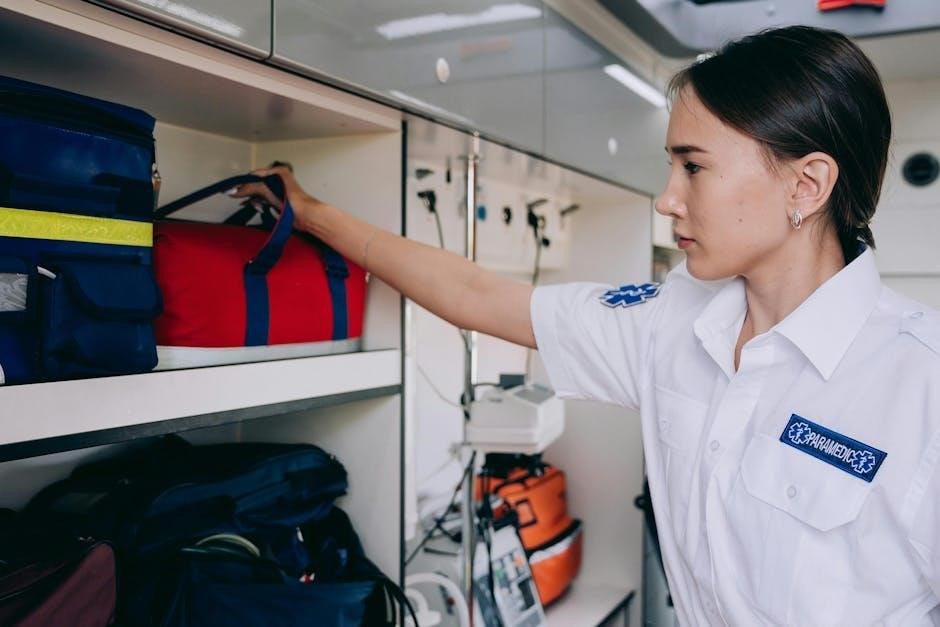
After Step 3
After sending for help, focus shifts to airway management, breathing, and CPR following the DRSABCD approach. These steps are critical for maintaining life support until professional medical assistance arrives.
Step 4: Airway Management
Airway management is a critical step in first aid, focusing on ensuring the casualty’s airway is clear and unobstructed. This step follows the DRSABCD approach, where the priority is to maintain an open airway to allow breathing. If the casualty is unconscious or unresponsive, gently tilt their head back and lift their chin to open the airway. Check for any visible blockages, such as food, vomit, or debris, and remove them if present. If the casualty is conscious, encourage them to cough or speak to assess their ability to clear their airway. Proper airway management prevents asphyxiation and ensures oxygen can reach the lungs. Always avoid forcing the casualty’s head into an unnatural position, as this could cause further harm; If the airway is blocked and the casualty cannot cough, back slaps or abdominal thrusts may be necessary. This step is vital before proceeding to assess breathing and providing CPR if needed.
Step 5: Breathing
After ensuring the airway is clear, the next step is to assess the casualty’s breathing. Look for chest movements, listen for breath sounds, and feel for air on your cheek. If the person is unresponsive and not breathing or exhibits irregular breathing, begin rescue breaths. Provide two breaths, each lasting one second, making sure the chest rises. If the casualty is breathing normally, continue to monitor their condition. Proper breathing assistance is essential to maintain oxygen supply to vital organs. This step ensures the casualty receives adequate ventilation until professional help arrives, making it a critical component of first aid care.
Step 6: CPR and Defibrillation
CPR (Cardiopulmonary Resuscitation) is performed when a casualty is unresponsive, not breathing, or has no pulse. It involves chest compressions and rescue breaths to maintain blood circulation and oxygen supply to vital organs. Place the heel of one hand on the center of the chest, place the other hand on top, and interlock your fingers. Push down to a depth of 5-6 cm at a rate of 100-120 compressions per minute. After every 30 compressions, give two breaths if trained to do so. Defibrillation, using an Automated External Defibrillator (AED), is critical for cardiac arrest cases. Attach the pads to the bare chest and follow the device’s instructions to deliver a shock if advised. CPR and defibrillation are lifesaving interventions that must be performed promptly and correctly to increase the chances of recovery. Proper training is essential to execute these steps effectively and confidently.

Evaluating Effectiveness
Evaluating effectiveness involves assessing the casualty’s response to care and repeating steps as needed. Adjustments are made based on observations to ensure optimal outcomes until professional help arrives. This step is crucial for maintaining patient stability and addressing any changes in condition promptly. Proper evaluation ensures that first aid measures remain effective and tailored to the casualty’s evolving needs. Continuous monitoring and timely adjustments are key to improving survival chances and reducing further complications. Effective evaluation is a critical component of first aid training, enabling responders to adapt their care dynamically. It underscores the importance of staying vigilant and proactive in emergency situations. By regularly reassessing the situation, first responders can ensure that their interventions remain appropriate and effective. This iterative process is essential for achieving the best possible outcomes in crisis scenarios. Regular evaluation also helps in identifying any immediate changes in the casualty’s condition that may require a different approach or urgent intervention. Overall, evaluating effectiveness is a cornerstone of successful first aid practice, ensuring that care remains aligned with the casualty’s needs throughout the emergency response process.
Assessing the Casualty’s Condition
Assessing the casualty’s condition involves evaluating their physical state to determine the severity of their injury or illness. This step is critical for providing appropriate care and ensuring the best possible outcomes. First, check for responsiveness by asking the person questions or gently tapping their shoulder. If they are unresponsive, proceed to assess their airway, breathing, and circulation (ABCs). Look for signs of breathing, such as chest movements or breath sounds, and feel for a pulse to determine circulation. Note any visible injuries, such as bleeding or deformities, and observe for symptoms like pale skin, sweating, or confusion. Use the DRSABCD approach to systematically evaluate danger, response, send for help, airway, breathing, and circulation. Continuously monitor the casualty’s condition for any changes, as this will guide further care and interventions. Accurate assessment ensures that first aid measures are targeted and effective, improving the chances of recovery and preventing further harm. Regular reassessment is essential until professional medical help arrives. By staying vigilant, responders can adapt care as needed to address evolving needs. This process underscores the importance of thorough observation and timely adjustments in first aid situations. Effective assessment is a cornerstone of providing quality care in emergencies. It enables responders to prioritize interventions and allocate resources effectively, maximizing the likelihood of a positive outcome. Through consistent monitoring and evaluation, first aiders can ensure that their actions remain aligned with the casualty’s needs, ultimately enhancing the effectiveness of their care. This iterative process of assessment and adjustment is vital for achieving the best possible results in critical situations.
After assessing the casualty’s condition, it is essential to adjust care based on the evaluation to ensure the best possible outcome. This step involves reviewing the initial interventions and making necessary modifications. For example, if breathing becomes labored, additional support like positioning or rescue breaths may be required. If bleeding increases, apply more pressure or use a tourniquet if trained. Always follow the DRSABCD framework, updating each component as needed. Continuously monitor vital signs and watch for any changes in the casualty’s responsiveness or physical state. Adjustments should be made calmly and methodically, ensuring that care remains appropriate and effective. Documentation of changes in condition and interventions is crucial for handover to medical professionals. By staying attentive and flexible, first responders can adapt their care to meet the evolving needs of the casualty, ultimately improving the likelihood of recovery. Regular reassessment and timely adjustments are key to delivering effective first aid. This process ensures that interventions remain aligned with the casualty’s current condition, maximizing the potential for a successful outcome. Through careful evaluation and adaptation, first aiders can provide targeted, responsive care that addresses the unique needs of each situation. This dynamic approach to first aid underscores the importance of continuous monitoring and the ability to adjust interventions as circumstances change. By staying proactive and informed, responders can deliver care that evolves alongside the casualty’s condition, ensuring the most favorable results. Adjusting care based on evaluation is a critical skill that enhances the effectiveness of first aid in all situations. It allows responders to address new symptoms, prevent complications, and maintain the highest standard of care until professional help arrives. This adaptability is a cornerstone of effective first aid, enabling responders to make a meaningful difference in emergencies. By integrating evaluation and adjustment into their approach, first aiders can provide comprehensive, patient-centered care that adapts to the unique demands of each scenario. This ensures that interventions remain relevant, effective, and tailored to the casualty’s needs, ultimately contributing to better health outcomes. The ability to adjust care based on ongoing evaluation is a vital component of first aid training and practice, emphasizing the importance of staying alert, informed, and responsive in all emergency situations. Access printable first aid guides, online courses, and Quizlet flashcards for comprehensive learning. Proper training equips individuals with essential skills and confidence to administer care effectively in emergencies, ensuring timely and appropriate interventions. Printable first aid guides are essential tools for quick reference during emergencies. They provide step-by-step instructions for administering care, ensuring clarity and precision. These guides can be downloaded and kept in easily accessible locations, such as homes, workplaces, or vehicles. Many guides focus on the DRSABCD approach, emphasizing key steps like assessing danger, checking for responsiveness, and sending for help. They often include visual aids and concise language, making them user-friendly. Topics typically covered include wound care, burns, choking, and cardiac arrest. Printable guides are particularly useful for training purposes, allowing individuals to practice and review first aid techniques. They are also invaluable in remote areas with limited internet access. By following these guides, individuals can deliver appropriate care confidently, reducing the risk of further harm. Overall, printable first aid guides are a practical resource for anyone seeking to learn and apply first aid effectively. Online first aid courses offer flexible and accessible training for individuals to learn life-saving skills. These courses cover essential topics such as the DRSABCD approach, emphasizing critical steps like sending for help (Step 3). They often include interactive modules, videos, and quizzes to engage learners. Many courses are designed for specific scenarios, such as cardiac arrest, burns, or choking, ensuring comprehensive coverage. The convenience of online learning allows participants to study at their own pace, fitting training into busy schedules. Reputable providers, like the American Red Cross, offer certified programs that teach practical skills and theoretical knowledge. Upon completion, learners receive certificates, demonstrating their proficiency in first aid. Online courses are particularly beneficial for those in remote areas or with limited access to in-person training. They empower individuals to act confidently in emergencies, making them an invaluable resource for first aid education. Quizlet flashcards are a popular study tool for learning first aid concepts, including the critical Step 3 of sending for help. These flashcards cover essential terms, definitions, and procedures, such as the DRSABCD approach and the 3 Cs of first aid (Check, Call, Care). Users can find sets that explain how to identify emergencies, provide care, and understand when to call for professional assistance. Flashcards also include scenarios like burns, choking, and cardiac arrest, helping learners memorize appropriate responses. Interactive features like tests and study games make learning engaging. Many sets focus on specific skills, such as airway management and CPR, ensuring a comprehensive understanding. Quizlet’s accessibility on mobile devices allows learners to study anytime, making it an effective resource for first aid training. These flashcards are particularly useful for visual learners and those seeking to reinforce knowledge before or after a formal course. Proper first aid training is essential for effectively applying life-saving techniques. It equips individuals with the skills and confidence to respond calmly in emergencies, ensuring timely and appropriate care. Training programs teach the 3 Cs of first aid—Check, Call, Care—and the DRSABCD approach, providing a structured framework for action. Hands-on practice allows learners to master techniques like airway management and CPR, which are critical in life-threatening situations. Proper training also fosters decision-making skills, enabling individuals to assess conditions accurately and act accordingly. Furthermore, it reduces panic and errors during emergencies, ensuring better outcomes for casualties. Training is not just about knowledge; it’s about applying that knowledge effectively. Regular updates and refreshers are vital to stay current with evolving first aid protocols. Without proper training, even the best intentions may fall short, emphasizing the importance of seeking guidance from qualified instructors.Adjusting Care Based on Evaluation
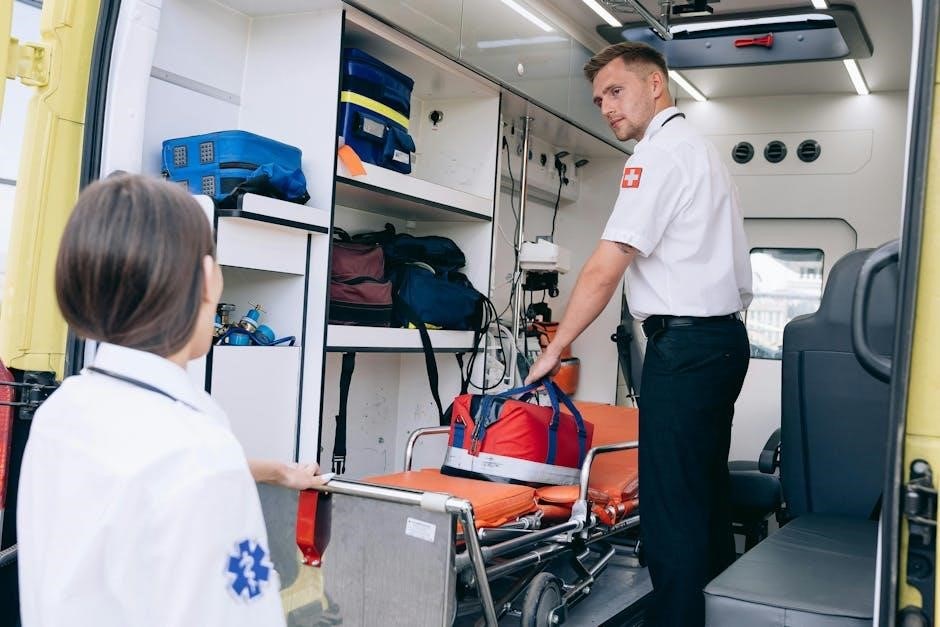
Resources and Training
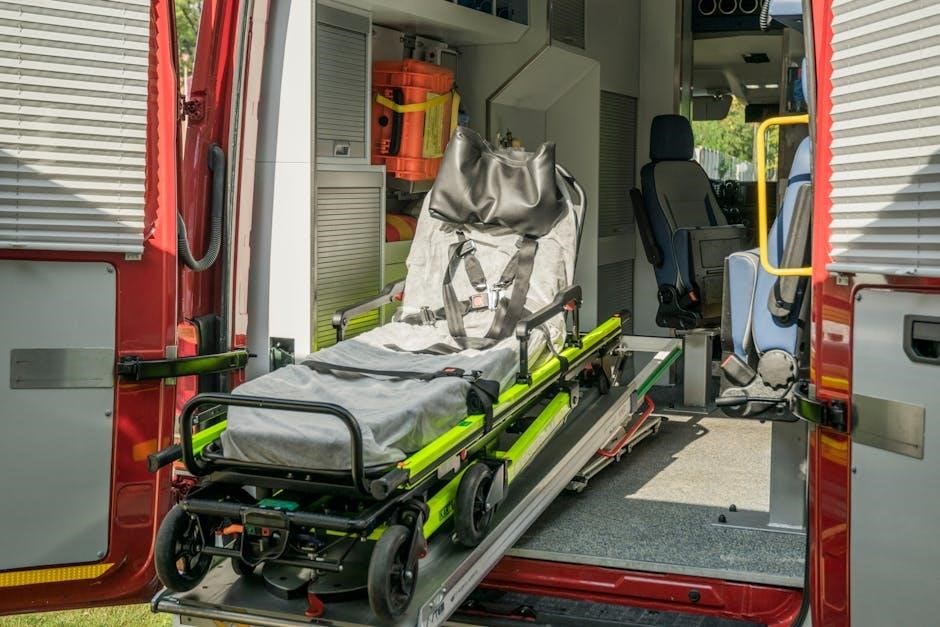
Printable First Aid Guides
Online First Aid Courses
Quizlet Flashcards for First Aid
Importance of Proper Training



